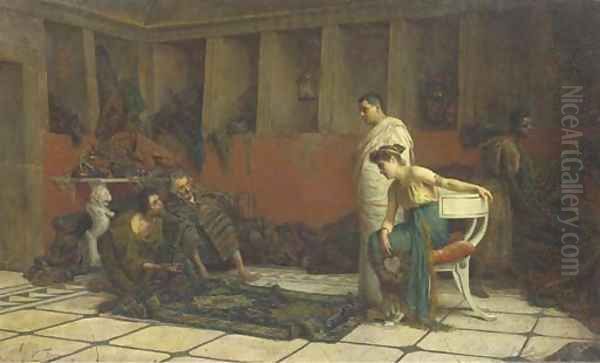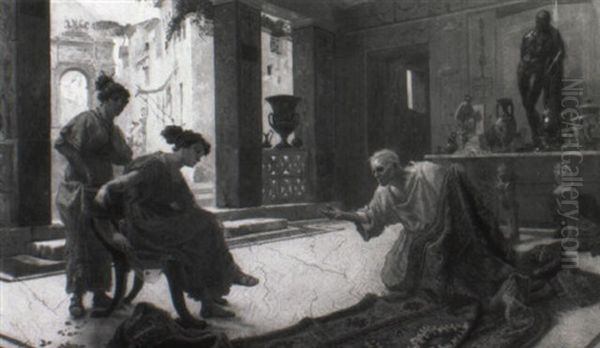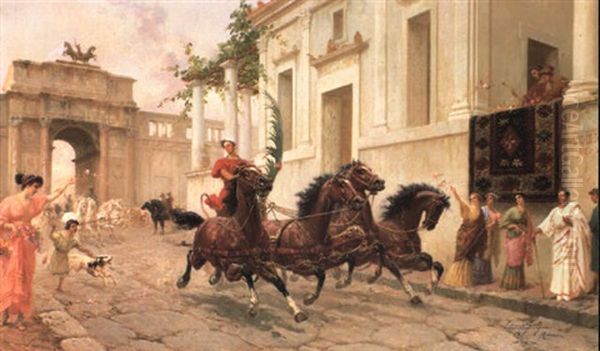Ettore Forti, an Italian painter active during the vibrant artistic period spanning the late nineteenth and early twentieth centuries, carved a distinct niche for himself through his evocative and meticulously detailed portrayals of life in ancient Rome. His canvases transport viewers to a bygone era, offering glimpses into the daily routines, grand spectacles, and intimate moments of a civilization that continues to captivate the Western imagination. Working within the popular Neo-Pompeian genre, Forti distinguished himself with a commitment to historical atmosphere and a painterly skill that brought the classical world to life with remarkable vividness. While biographical details about the artist remain somewhat scarce, his body of work speaks volumes, securing his place among the notable historical genre painters of his time.
The Enigmatic Life of a Roman Painter
The precise details of Ettore Forti's birth and early life are not extensively documented, a common occurrence for many artists of his era who did not achieve the towering fame of some of their contemporaries during their lifetimes. It is generally accepted that he was an Italian national, and his strong thematic focus on Rome, coupled with the frequent signature "E. Forti, Roma" on his works, suggests a deep connection to the Eternal City, whether as a place of birth, residence, or profound artistic inspiration. He is believed to have been active primarily from the 1880s into the early 1900s, a period that saw a fervent interest in historical and archaeological subjects across Europe.

Some sources suggest a birth year around 1850, while others place his activity more firmly in the last two decades of the 19th century and the first decade of the 20th. This ambiguity, however, does not detract from the clarity of his artistic output. Forti's paintings demonstrate a thorough understanding of classical architecture, attire, and customs, indicating a dedicated study of archaeological findings and historical texts. His participation in exhibitions, such as those in Berlin between 1893 and 1897 and an exhibition by the Rome Artists' Association in 1905, confirms his presence within the professional art circles of the time. These exhibitions would have provided him with platforms to showcase his unique interpretations of ancient life to a wider audience, an audience increasingly fascinated by the discoveries then emerging from sites like Pompeii and Herculaneum.
The Allure of the Neo-Pompeian Style
Ettore Forti's artistic practice was firmly rooted in the Neo-Pompeian style, a genre that gained immense popularity in the latter half of the 19th century. This style was fueled by the ongoing archaeological excavations at Pompeii and Herculaneum, which unveiled remarkably preserved remnants of Roman daily life, art, and architecture. Artists and the public alike were enthralled by these windows into the past, leading to a demand for artworks that recreated classical antiquity with a sense of realism and immediacy. The Neo-Pompeian artists sought to move beyond the idealized, often mythological, classicism of earlier periods, instead focusing on genre scenes, domestic interiors, and everyday occurrences.
Forti excelled in this domain, creating compositions that were both archaeologically informed and aesthetically pleasing. His paintings often feature bustling market scenes, quiet domestic moments, leisurely activities in opulent villas, or dramatic public events. The appeal of such works lay in their ability to make the distant past feel tangible and relatable. Viewers could imagine themselves walking the streets of ancient Rome, observing its inhabitants, and experiencing its culture. This desire for historical immersion was a hallmark of the Victorian and Edwardian eras, and painters like Forti catered to this fascination with considerable skill. His approach was characterized by a careful attention to detail, a rich color palette, and a talent for narrative composition that drew the viewer into the depicted scene.
Influences and Artistic Contemporaries
Ettore Forti's work did not exist in an artistic vacuum. He was part of a broader European movement of historical genre painting, and his style shares affinities with several prominent artists of the period. Perhaps the most notable comparison is with the Dutch-born, British-based painter Sir Lawrence Alma-Tadema (1836-1912). Alma-Tadema was a towering figure in the depiction of classical antiquity, renowned for his "Victorians in togas" – exquisitely detailed scenes of Roman and Egyptian life, often set against backgrounds of gleaming marble and vibrant flowers. Forti, like Alma-Tadema, demonstrated a similar preoccupation with archaeological accuracy in depicting settings, costumes, and objects, creating a sense of authenticity that appealed to contemporary audiences.

Other artists exploring similar themes included the French academic painter Jean-Léon Gérôme (1824-1904), whose historical and Orientalist scenes were celebrated for their meticulous realism and dramatic flair, often depicting gladiatorial contests or scenes from Roman history. In Britain, artists like Sir Edward Poynter (1836-1919) and Lord Frederic Leighton (1830-1896) also produced grand canvases inspired by classical mythology and history, though often with a more idealized and heroic tone than the everyday scenes favored by Forti. The Italian artistic landscape itself was rich with painters engaging with their national heritage. Giulio Aristide Sartorio (1860-1932), though also associated with Symbolism, produced significant historical works. Earlier in the 19th century, Francesco Hayez (1791-1882) had been a leading figure in Italian Romantic historical painting, setting a precedent for large-scale narrative works.
Forti's specific connection with Luigi Bazzani (1836-1927), another Italian painter, is noteworthy. Bazzani, also known as "Bazzanetto," was particularly renowned for his highly detailed watercolors and oil paintings of Pompeian ruins and reconstructions of ancient Roman life. Both artists shared a passion for bringing the archaeological discoveries of Pompeii to life on canvas, and it is documented that they both addressed themes such as the "Pompeii Street." While the exact nature of their collaboration or mutual influence is not fully detailed, their shared thematic focus places them in a similar artistic orbit. Other Italian contemporaries who explored historical or genre scenes with a similar dedication to realism included Domenico Morelli (1823-1901), known for his historical and religious subjects infused with vibrant color and emotional intensity, and the Spanish-born but internationally influential Mariano Fortuny y Marsal (1838-1874), whose dazzling technique and detailed genre scenes had a profound impact on many European artists. The Russian painter Karl Bryullov (1799-1852) had earlier captivated Europe with "The Last Day of Pompeii," a monumental work that undoubtedly influenced subsequent generations of artists depicting classical antiquity. We can also consider painters like Gustave Boulanger (1824-1888) in France, who also specialized in Pompeian and Roman scenes, or the British artist Edwin Long (1829-1891), who painted elaborate scenes from ancient history.
A Glimpse into Forti's Masterpieces
Ettore Forti's oeuvre is characterized by a consistent dedication to his chosen subject matter. Several works stand out as representative of his style and thematic concerns, offering a rich tapestry of ancient Roman existence.

One of his most frequently cited paintings is "The Carpet Seller" (sometimes titled "Selling the Carpet" or "The Rug Merchant"). This work typically depicts a vibrant market scene, likely within a Roman forum or a wealthy villa's courtyard. A merchant unfurls an ornate carpet, its rich colors and intricate patterns forming a central focus, while potential buyers—often elegantly robed patrician women—examine the goods with discerning eyes. Such scenes allowed Forti to showcase his skill in rendering diverse textures, from the softness of textiles to the coolness of marble architecture and the sheen of metal ornaments. The interplay of characters, their gestures, and expressions create a lively narrative, inviting speculation about the transaction and the social dynamics at play.
Another significant work often attributed to him is "A Day in Ancient Rome" or "Daily Life in Ancient Rome." This title encompasses a theme rather than a single, specific composition, as Forti produced numerous paintings illustrating various facets of Roman quotidian life. These might include scenes of women at their toilette, scholars in a library, families relaxing in their atriums, or artisans at work. These paintings are valuable for their attempts to reconstruct the material culture of the Roman world, populating them with figures engaged in relatable, everyday activities. The settings are often meticulously rendered, featuring architectural details, frescoes, mosaics, and furniture based on archaeological evidence.
"The Merchant of Pompeii" is another title that points to Forti's engagement with the doomed city. Such a work would likely depict a bustling commercial scene within Pompeii, perhaps moments before the catastrophic eruption of Vesuvius, or simply as a representation of its vibrant commercial life. These paintings often capture the energy of Pompeian street life, with vendors, shoppers, and passersby creating a dynamic tableau. Forti's ability to convey the atmosphere of a specific historical location was a key element of his appeal.
The theme of "Caesar's Arrival" or similar depictions of triumphal entries and public ceremonies also features in his work. These compositions allowed for grander scales, more figures, and a sense of historical import. Such paintings would often focus on the spectacle of Roman power and pageantry, with legions marching, crowds cheering, and prominent figures taking center stage. Forti's skill in managing complex multi-figure compositions would have been paramount in these works, as would his ability to convey the grandeur of Roman civic architecture.
Beyond these specific titles, Forti's paintings frequently explored themes such as "A Visit to the Jeweler," where elegantly dressed women admire precious ornaments, or "The Chariot Race," capturing the thrill and danger of this popular Roman spectacle. His depictions of "Interior of a Roman Building with Figures" allowed him to explore the interplay of light and shadow within classical architectural spaces, often highlighting the opulent decorations and the leisurely pursuits of their inhabitants. Each work, whether depicting a grand public event or an intimate private moment, is imbued with Forti's characteristic attention to detail and his desire to create a believable and engaging vision of the past.
Artistic Vision and Technical Prowess
Ettore Forti's artistic vision was centered on the faithful yet picturesque reconstruction of ancient Roman life. He aimed not merely to illustrate historical events but to evoke the spirit and atmosphere of the classical world. His paintings are characterized by a clear, luminous quality of light, which illuminates the scenes and highlights the textures of fabrics, marble, and metalwork. His color palette is typically rich and varied, employing vibrant hues to depict the opulent clothing, decorative frescoes, and lush gardens of Roman villas.
Compositionally, Forti's works are carefully constructed to lead the viewer's eye through the scene and to create a sense of depth and space. He often employed strong diagonal lines and perspectival recession to enhance the illusion of three-dimensionality. Figures are typically well-drawn and animated, engaged in activities that contribute to the overall narrative of the painting. While his figures may sometimes appear somewhat idealized, in keeping with the academic traditions of the time, they are generally rendered with a naturalism that makes them relatable.
A hallmark of Forti's technique is his meticulous attention to detail. He painstakingly rendered architectural elements, furniture, pottery, jewelry, and clothing, often drawing on archaeological sources for accuracy. This commitment to verisimilitude was highly valued by his contemporaries and contributed significantly to the perceived authenticity of his scenes. However, Forti was not merely a slavish copyist of archaeological artifacts; he skillfully integrated these details into harmonious and aesthetically pleasing compositions, balancing historical accuracy with artistic license to create engaging and evocative images. His brushwork is generally smooth and controlled, allowing for a high degree of finish and a clear delineation of forms.
Exhibitions, Reception, and Legacy
Ettore Forti's participation in exhibitions in major European cities like Berlin, as well as in his native Italy, indicates that his work was recognized and appreciated during his lifetime. The late 19th and early 20th centuries saw a burgeoning middle and upper class with an appetite for art, and historical genre paintings like Forti's found a ready market. These works appealed to a sense of nostalgia for the classical past, which was seen as a foundation of Western civilization, and also to a contemporary interest in history and archaeology. His paintings would have adorned the walls of affluent homes, offering a window onto a world of perceived elegance, order, and grandeur.
The popularity of the Neo-Pompeian style, and thus of artists like Forti, began to wane with the rise of modern art movements in the early 20th century. Styles that emphasized realism, narrative, and historical subject matter were increasingly overshadowed by Impressionism, Post-Impressionism, Cubism, and other avant-garde approaches. As a result, many academic and historical genre painters of the 19th century, including Forti, fell into relative obscurity for a period.
However, in more recent decades, there has been a renewed scholarly and public interest in 19th-century academic art. Artists like Ettore Forti are being reassessed for their technical skill, their contribution to the visual culture of their time, and their role in shaping popular perceptions of history. His paintings are now sought after by collectors and can be found in various private and public collections. They continue to be appreciated for their charm, their meticulous craftsmanship, and their ability to transport viewers to the ancient world.
Ettore Forti's legacy lies in his contribution to the rich tradition of historical genre painting. He was a skilled interpreter of ancient Roman life, creating works that were both informative and aesthetically engaging. His paintings offer a fascinating glimpse into how the 19th century viewed and imagined classical antiquity, and they stand as a testament to the enduring allure of the Roman world. While the grand narratives of modernism once overshadowed such art, the detailed, evocative, and beautifully rendered scenes by Ettore Forti remind us of the diverse artistic currents that shaped the visual landscape of his era and continue to offer delight and insight to contemporary audiences. His dedication to capturing the essence of ancient Rome, from its bustling public squares to its serene private villas, ensures his enduring, if quiet, place in the annals of art history.